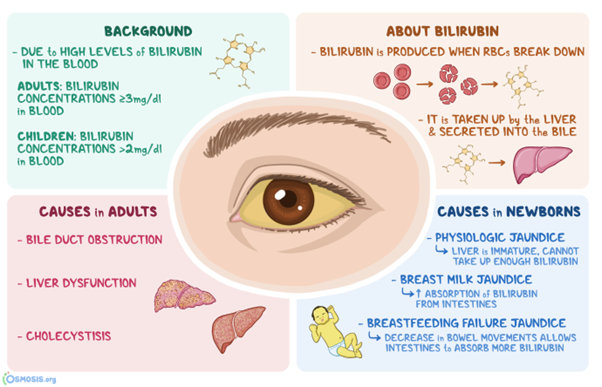A nurse is performing a skin assessment on a client who has a dark skin. Which one of the following locations on the client’s body should the nurse observe to access for jaundice?
Face
Shoulders
Palm of the hands
Sclera
The Correct Answer is D
Choice A reason:
Face is incorrect: Facial skin colour can vary for many reasons, but it may not be the best indicator of jaundice in individuals with dark skin.
Choice B reason
Shoulders is incorrect: The shoulders are not typically indicative of jaundice.
Choice C reason:
Palm of the hands is incorrect: While the palm of the hands can sometimes show yellowing in cases of jaundice, it is less reliable than observing the sclera.
Choice D reason:
Sclera is the best location. In individuals with darker skin tones, yellowish discoloration of the skin due to jaundice can be more challenging to detect. However, the sclera of the eyes can still show noticeable yellowing, making it a reliable location for assessing jaundice in individuals with both light and dark skin.

Nursing Test Bank
Naxlex Comprehensive Predictor Exams
Related Questions
Correct Answer is A
Explanation
Choice A reason:
Urine specific gravity is the measurement of the concentration of solutes in urine and is an important indicator of the client's hydration status and kidney function. A specific gravity of 1.035 is relatively high, suggesting concentrated urine. High urine specific gravity can be a sign of dehydration or other kidney-related issues.
Reporting this finding to the provider is crucial because it could indicate potential problems with the client's fluid balance and kidney function. The provider may need to assess further, conduct additional tests, or initiate appropriate interventions to address the client's hydration and renal status.
Choice B reason:
Prealbumin: A prealbumin level of 25 mg/dL is within the normal range (usually 15-35 mg/dL) and may not require immediate reporting to the provider. Prealbumin is used to assess nutritional status, and this result suggests that the client's nutritional status is within the normal range.
Choice C reason:
Temperature: The normal range is 36.5°-37.5°C (97.7°-99.5°F),thus it falls within normal range.
Choice D reason
Bowel sounds: Bowel sounds:Bowel sounds heard is a normal finding and indicates normal gastrointestinal function.
Correct Answer is A
Explanation
A. Correct. Avoiding exposure to tobacco smoke is one of the measures to prevent SIDS, as it can affect the respiratory function and arousal of the newborn.
B. Incorrect. Placing bumper pads in the baby's crib is not recommended, as they can pose a suffocation or strangulation hazard for the newborn.
C. Incorrect. Placing the baby's head on a pillow for sleeping is not advised, as it can increase the risk of suffocation or rebreathing of carbon dioxide for the newborn.
D. Incorrect. Placing the baby in a side-lying position for sleeping is not suggested, as it can increase the likelihood of rolling over to a prone position, which is associated with a higher incidence of SIDS.
Whether you are a student looking to ace your exams or a practicing nurse seeking to enhance your expertise , our nursing education contents will empower you with the confidence and competence to make a difference in the lives of patients and become a respected leader in the healthcare field.
Visit Naxlex, invest in your future and unlock endless possibilities with our unparalleled nursing education contents today
Report Wrong Answer on the Current Question
Do you disagree with the answer? If yes, what is your expected answer? Explain.
Kindly be descriptive with the issue you are facing.
